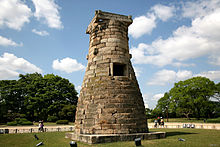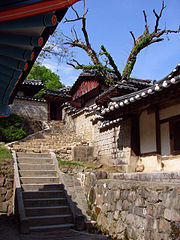- Daegu-Gyeongbuk
-
Daegu-Gyeongbuk Hangul 대구경북 Hanja 大邱慶北 Revised Romanization Daegu-Gyeongbuk McCune–Reischauer Taegu-Kyŏngbuk Daegu-Gyeongbuk (대구경북, 大邱慶北) is the compound word of Daegu and Gyeongbuk (formally Gyeongsangbuk-do), and indicates both administrative provinces in South Korea. With a population of 5.05 million,[1] the region usually forms the same political, economic, and cultural area, although it is not an administratively unitary region. Daegu is an independent city from Gyeongsangbuk-do and has the same status with its mother province. Both have their separate local governments reporting directly to the national government.
There are many cities in this region including Daegu as the foremost city, Pohang as the major port city, Gumi as the major industrial city, Gyeongju and Andong as the historic cities. The region has about one tenth of South Korea's population and GDP, and has the third largest metropolitan area centering the Daegu city.
Contents
History
See also: History of Daegu and Silla#History Cheomseongdae of Gyeongju
Cheomseongdae of Gyeongju Dosan Seowon of Andong
Dosan Seowon of Andong
Historically, the region was the birthplace of the Silla Kingdom. With Gyeongju as the capital city, it developed and left a number of remains in and around the city. The Gyeongju Historic Areas are a World Heritage Site, listed by UNESCO in 2000. In Goryeo and Joseon Dynasty, it formed Gyeongsang-do. Its name comes from a portmanteau word of Gyeongju and Sangju, the two large cities at that time. In the latter part of Joseon, it was home to the Korean Confucianism. Many tangible and intangible cultural assets can be seen throughout the region, especially in its northern part including Andong. In 2010, the Hahoe Folk Village of Andong and the Yangdong Folk Village of Gyeongju designated as the UNESCO World Heritage Sites.[2] At the same time, the commercial center of the region moved to Daegu from Sangju and Gyeongju. The city also has been the provincial capital since 1601. The current boundary of the region was first defined with the name of Gyeongsangbuk-do in 1896, the year when Gyeongsang-do was divided into Gyeongsangbuk-do and Gyeongsangnam-do. It had the largest population in the country until its division in 1981, when Daegu separated from Gyeongsangbuk-do. The provincial office of Gyeongsangbuk-do still remains in Daegu.
Subdivisions
It consists of Daegu (formally Daegu Metropolitan City) and Gyeongsangbuk-do. Daegu is divided into 7 wards (Gu) and 1 county (Gun), while Gyeongsangbuk-do is divided into 10 cities (Si) and 13 counties (Gun).
Daegu
Main article: Administrative divisions of Daegu7 gu's
- Suseong-gu (수성구, 壽城區)
- Dalseo-gu (달서구, 達西區)
1 gun
- Dalseong-gun (달성군, 達城郡)
Gyeongsangbuk-do
Main article: Cities and Counties of Gyeongsangbuk-do10 si's
- Sangju (상주시, 尙州市)
- Yeongcheon (영천시, 永川市)
- Yeongju (영주시, 榮州市)
13 gun's
- Bonghwa (봉화군, 奉化郡)
- Cheongdo (청도군, 淸道郡)
- Cheongsong (청송군, 靑松郡)
- Chilgok (칠곡군, 漆谷郡)
- Goryeong (고령군, 高靈郡)
References
- ^ "지역별 인구 및 인구밀도". Statistics Korea. 2009. http://www.index.go.kr/egams/stts/jsp/potal/stts/PO_STTS_IdxMain.jsp?idx_cd=1007&bbs=INDX_001&clas_div=C&rootKey=1.48.0. Retrieved 2009-11-29.
- ^ http://www.koreatimes.co.kr/www/news/nation/2010/08/117_70595.html
Categories:
Wikimedia Foundation. 2010.

